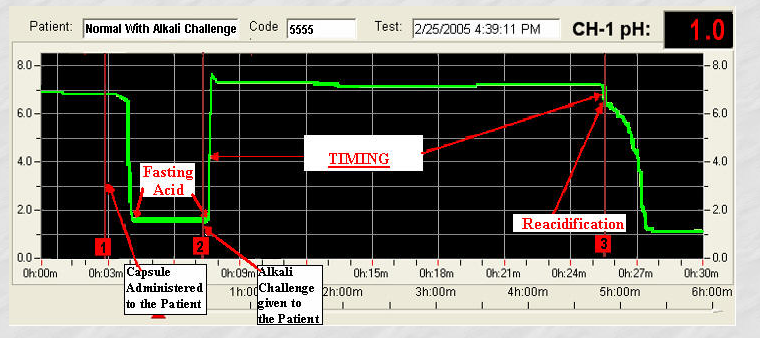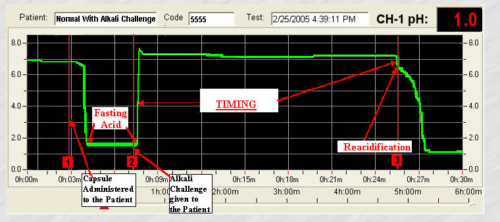3 Tests for Low Stomach Acid

Did you know stomach acid is actually good for you? Dr. Jonathan Wright wrote a whole book on the topic because he felt it was so important for overall health. In fact, most people I talk with who think they have high acid levels actually have low acid levels. This is why it is so important to test and find out for sure.
Proper stomach acid production is vital to unlocking perfect digestion. The digestive process downstream from the stomach is controlled chiefly by pH changes. When the food (chyme) in your stomach reaches a pH of about 2-4, the valve at the bottom of the stomach (pyloric sphincter) starts to slowly release the stomach contents into the duodenum. From here, the pH raises up and down as it travels through the intestines and out the other end.
If the pH is wrong from the beginning, everything downstream from the small intestine to the large intestine will likely be compromised. Think of it like this: chewing your food is the first crucial step to perfect digestion and stomach acid is the next most important.
Low stomach acid can cause diarrhea just as fast as it can cause constipation so don’t think that it’s only confined to one or the other. If you have any digestive problems at all, this is one problem you must rule out or you may never unlock total health.
There are 3 different tests you could do to find out if you have low stomach acid.
Remember, not all tests are created the same. In this case, the more time and money you invest the better your results will be. However, most people won’t need to break the bank to figure this out.
The Heidelberg Stomach Acid Test
The gold standard medical test for low stomach acid available right now is called “The Heidelberg Stomach Acid Test.” This test is the most costly of the bunch, but it will give you exact, non-biased results you need to analyze your stomach acid. It usually costs around $350 and unfortunately most insurance plans won’t cover it. But always call ahead because prices change and so does insurance coverage.
The Heidelberg test works by using a small capsule with a radio transmitter that records the pH of your stomach as you drink a solution of Sodium Bicarbonate. The result of the test is a graph showing your pH levels at regular intervals of time.
It really doesn’t get any more descriptive than this. Plus, there have been more than 140 scientific studies to back it up.
The Heidelberg Stomach Acid Test Protocol
- Fast for 8-12 hours and no acid suppressing drugs for at least 4 days prior to test
- Swallow a small pill-sized capsule
- Drink a solution of Sodium bicarbonate
- The test will continuously record the pH in your stomach for as long as needed
Upon conclusion of the test, you’ll have a graph showing your specific stomach response to the challenge solution. From this test, the doctor can determine if you have any forms of hypochlorhydria, hyperchlorhydria, or achlorhydria. This is the best test for all stomach acid related problems.
The Baking Soda Stomach Acid Test
This test works by drinking baking soda and creating a chemical reaction in your stomach between the baking soda (sodium bicarbonate) and hydrochloric acid (HCL). The result is carbon dioxide gas that causes burping. Ingesting baking soda is an old school natural home remedy for upset stomachs. This test will only cost you about $3 if you need to buy a new box of baking soda. Many people choose to try this test first because it’s very safe, low cost and you can get started tomorrow if it is in the cupboard.
But, there are problems with this test. Overall, there are a lot of variables to control. Trying to minimize all the variables can be tough and I would recommend performing the test 3 consecutive mornings to find an average. By doing this, you’re looking for more of a pattern than a one time test of “yes” or “no.” Also, to increase accuracy of the test, you must do it as soon as you wake up in the morning before putting anything in your mouth.
For the record, I’m unaware of any scientific studies that prove this method of stomach acid testing is either reliable or accurate. The results of this test can vary widely and it’s up to your interpretation, both of which are not ideal.
Here’s the Quick, at Home Way to See if You Have Low Stomach Acid
- Mix 1/4 teaspoon of baking soda in 4-6 ounces of cold water first thing in the morning before eating or drinking anything.
- Drink the baking soda solution.
- Time how long it takes you to belch. Time up to five minutes.
If you have not belched within five minutes, stop timing.
In theory, if your stomach is producing adequate amounts of stomach acid you’ll likely belch within two to three minutes. Early and repeated belching may be due to excessive stomach acid (but don’t confuse these burps with small little burps from swallowing air when drinking the solution). Any belching after 3 minutes indicates a low acid level.
Because the time frames can vary person-to-person, as well as how they drink the solution, this test is only a good indicator that you might want to do more testing to determine your stomach acid.
This test is not accurate enough to rule out low stomach acid. To rule out low stomach acid, you will need to try the Heidelberg test or Betaine HCL challenge test.
Betaine HCL Challenge Test for Low Stomach Acid
The most reliable test you can perform at home is the Betaine HCL challenge test. In fact, if you do enough searching on the web, you’ll find several health websites who will try to sell you a kit to perform the steps below (don’t fall for this, duh). This test can be performed safely, if you follow the directions below. It will cost you around $20 or less to do this test.
Note: NSAIDs and Corticosteroids increase the chances of ulcers in the stomach and, together with Betaine HCL, increase the risk of gastritis. Consult a physician before trying this test or supplementing.
Each case of low stomach acid is unique and will require a custom dosage of HCL. But one way you can find out if you have low stomach acid is by using Betaine HCL supplements. Dr. Jonathan Wright suggests using (1) 650mg or less pill that includes Pepsin.
To Perform the Test, Do the Following:
- Buy some Betaine HCL with pepsin (like HCl Guard+ by Healthy Gut Nutrition)
- Eat a high protein meal of at least 6 ounces of meat
- In the middle of the meal, take 1 Betaine HCL pill
- Finish your meal as normal and pay attention to your body
There’s really only 2 outcomes from this test:
- The first is that you won’t notice anything. As you go about your normal life after the meal, nothing will change. This means it is very likely you have low stomach acid levels.
- If, as you go about your normal life, you start to feel stomach distress characterized as heaviness, burning, or hotness – then these are signs that you don’t have low acid levels.
This test isn’t completely foolproof either and should be repeated at least one more time on a different day to confirm the first test. One of the biggest causes of false test results is the amount of protein eaten at the meal, so make sure to eat a chunk of meat with the test. If you do get some burning, don’t worry it will pass in about an hour. You can also mix up a ½ teaspoon of baking soda and drink it to help stop the discomfort.
After getting 2 positive tests, it is time to start supplementing with Betaine HCL to get your stomach acid levels where they need to be for good digestion.
I Have Low Stomach Acid, Now What?
If you do find out you have low stomach acid, the prescription is pretty simple. In the short-term, you need to supplement your acid levels to allow the rest of the digestive process to work properly.
Natural supplement options include apple cider vinegar and digestive bitters. But most people will usually need to supplement with Betaine HCL as a replacement for the low acid. It is thought that Betaine HCL will retrain your stomach to get to the correct pH levels over time. What is known is it will allow your digestion to work correctly in the interim.
Long-term, you need to work on finding the root cause problem and taper off the supplements.
With that in mind, Jordan and I have put together a dedicated, 3-hour presentation on how to heal from the damage of low stomach acid naturally by addressing the root causes of acid reflux.
I urge you to check it out here: http://heartburnhelp.scdlifestyle.com
During this presentation, we’ll help you understand the most important short-term and long-term strategies to start naturally taking control of this condition.
What We Cover During the ‘Getting Rid of Heartburn’ Presentation:
- The 3 steps, “rest, repair, and reset,” to unlock your body’s natural ability to heal from the damage of years of antacid pills
- How to break free of the dependence on pills holding you back from life-changing restoration of healthy stomach acid levels
- The sneaky little root causes that keep your stomach acid low – even after you’ve stopped the pills – and keep the cycle of heartburn raging
- What you MUST be avoiding in order for your stomach to heal (or the symptoms will come right back)
- The step-by-step process we’ve used to naturally get rid of heartburn and restore normal stomach acid levels (even if you’ve been on PPIs for 20 years)
- Why food is critical – and not so critical – for your long-term success getting rid of heartburn
- A simple method for cultivating normal stomach acid levels that trigger great digestion… even for some foods you couldn’t tolerate before
- Specific supplements to take – and other ones to avoid – on your road to healing the stomach and fixing your heartburn
- Why H. pylori, SIBO, Hormones, and other root causes could be the REAL reason you’re still suffering from heartburn, even though you’ve done everything else right
- Plus, much more…
Click here to get this life-changing information: http://heartburnhelp.scdlifestyle.com
Betaine HCL supplementation is a safe way to have great digestion and make sure you’re getting the nutrients you need from your foods. Have you tried it yet? Tell us about your experiences in the comments.
Did You Like this Article?
Subscribe to our newsletter to receive email notifications, some ways to find relief, and next steps.


